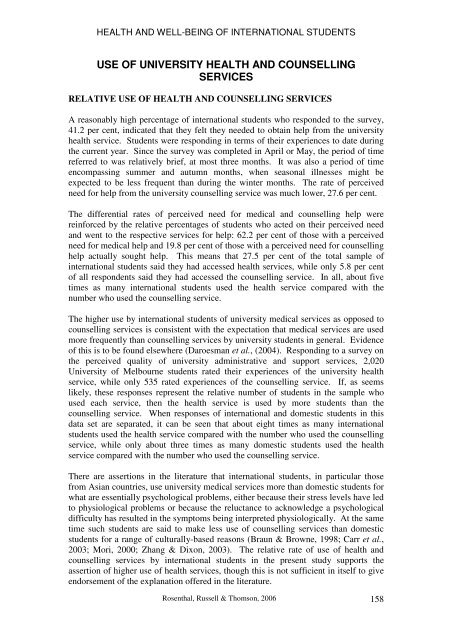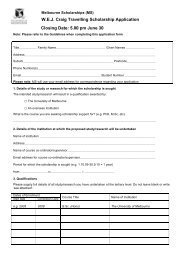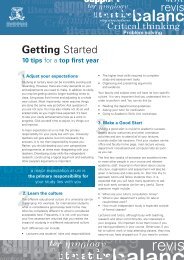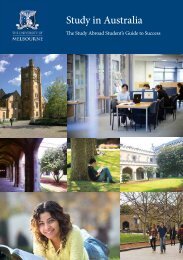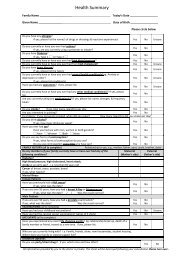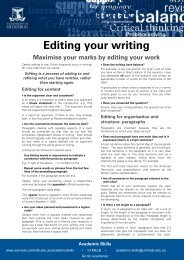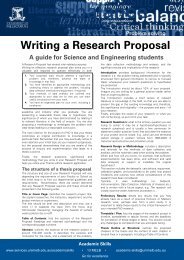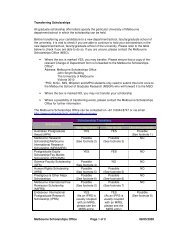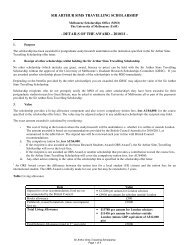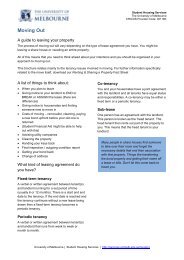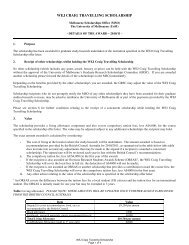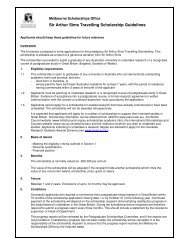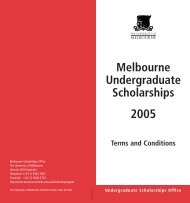a growing experience - Student Services - University of Melbourne
a growing experience - Student Services - University of Melbourne
a growing experience - Student Services - University of Melbourne
Create successful ePaper yourself
Turn your PDF publications into a flip-book with our unique Google optimized e-Paper software.
HEALTH AND WELL-BEING OF INTERNATIONAL STUDENTSUSE OF UNIVERSITY HEALTH AND COUNSELLINGSERVICESRELATIVE USE OF HEALTH AND COUNSELLING SERVICESA reasonably high percentage <strong>of</strong> international students who responded to the survey,41.2 per cent, indicated that they felt they needed to obtain help from the universityhealth service. <strong>Student</strong>s were responding in terms <strong>of</strong> their <strong>experience</strong>s to date duringthe current year. Since the survey was completed in April or May, the period <strong>of</strong> timereferred to was relatively brief, at most three months. It was also a period <strong>of</strong> timeencompassing summer and autumn months, when seasonal illnesses might beexpected to be less frequent than during the winter months. The rate <strong>of</strong> perceivedneed for help from the university counselling service was much lower, 27.6 per cent.The differential rates <strong>of</strong> perceived need for medical and counselling help werereinforced by the relative percentages <strong>of</strong> students who acted on their perceived needand went to the respective services for help: 62.2 per cent <strong>of</strong> those with a perceivedneed for medical help and 19.8 per cent <strong>of</strong> those with a perceived need for counsellinghelp actually sought help. This means that 27.5 per cent <strong>of</strong> the total sample <strong>of</strong>international students said they had accessed health services, while only 5.8 per cent<strong>of</strong> all respondents said they had accessed the counselling service. In all, about fivetimes as many international students used the health service compared with thenumber who used the counselling service.The higher use by international students <strong>of</strong> university medical services as opposed tocounselling services is consistent with the expectation that medical services are usedmore frequently than counselling services by university students in general. Evidence<strong>of</strong> this is to be found elsewhere (Daroesman et al., (2004). Responding to a survey onthe perceived quality <strong>of</strong> university administrative and support services, 2,020<strong>University</strong> <strong>of</strong> <strong>Melbourne</strong> students rated their <strong>experience</strong>s <strong>of</strong> the university healthservice, while only 535 rated <strong>experience</strong>s <strong>of</strong> the counselling service. If, as seemslikely, these responses represent the relative number <strong>of</strong> students in the sample whoused each service, then the health service is used by more students than thecounselling service. When responses <strong>of</strong> international and domestic students in thisdata set are separated, it can be seen that about eight times as many internationalstudents used the health service compared with the number who used the counsellingservice, while only about three times as many domestic students used the healthservice compared with the number who used the counselling service.There are assertions in the literature that international students, in particular thosefrom Asian countries, use university medical services more than domestic students forwhat are essentially psychological problems, either because their stress levels have ledto physiological problems or because the reluctance to acknowledge a psychologicaldifficulty has resulted in the symptoms being interpreted physiologically. At the sametime such students are said to make less use <strong>of</strong> counselling services than domesticstudents for a range <strong>of</strong> culturally-based reasons (Braun & Browne, 1998; Carr et al.,2003; Mori, 2000; Zhang & Dixon, 2003). The relative rate <strong>of</strong> use <strong>of</strong> health andcounselling services by international students in the present study supports theassertion <strong>of</strong> higher use <strong>of</strong> health services, though this is not sufficient in itself to giveendorsement <strong>of</strong> the explanation <strong>of</strong>fered in the literature.Rosenthal, Russell & Thomson, 2006 158


